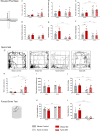Maternal stress and vulnerability to depression: coping and maternal care strategies and its consequences on adolescent offspring
- PMID: 36333302
- PMCID: PMC9636172
- DOI: 10.1038/s41398-022-02220-5
Maternal stress and vulnerability to depression: coping and maternal care strategies and its consequences on adolescent offspring
Abstract
Depressive mothers often find mother-child interaction to be challenging. Maternal stress may further impair mother-child attachment, which may increase the risk of negative developmental consequences. We used rats with different vulnerability to depressive-like behavior (Wistar and Kyoto) to investigate the impact of stress (maternal separation-MS) on maternal behavior and adolescent offspring cognition. MS in Kyoto dams increased pup-contact, resulting in higher oxytocin levels and lower anxiety-like behavior after weaning, while worsening their adolescent offspring cognitive behavior. Whereas MS in Wistar dams elicited higher quality of pup-directed behavior, increasing brain-derived neurotrophic factor (BDNF) in the offspring, which seems to have prevented a negative impact on cognition. Hypothalamic oxytocin seems to affect the salience of the social environment cues (negatively for Kyoto) leading to different coping strategies. Our findings highlight the importance of contextual and individual factors in the understanding of the oxytocin role in modulating maternal behavior and stress regulatory processes.
© 2022. The Author(s).
Conflict of interest statement
All authors report no conflicts of interest. The results and discussion here presented were previously posted as a preprint at bioRxiv on February 24, 2021 (10.1101/2021.02.23.432580).
Figures






References
-
- Righetti-Veltema M, Conne-Perreard E, Bousquet A, Manzano J. Postpartum depression and mother-infant relationship at 3 months old. J Affect Disord. 2002;70:291–306. - PubMed
-
- Fleming AS, O’Day DH, Kraemer GW. Neurobiology of mother–infant interactions: experience and central nervous system plasticity across development and generations. Neurosci Biobehav Rev. 1999;23:673–85. - PubMed
-
- Alves RL, Portugal CC, Summavielle T, Barbosa F, Magalhaes A. Maternal separation effects on mother rodents’ behaviour: a systematic review. Neurosci Biobehav Rev. 2020;117:98–109. - PubMed
-
- Insel TR, Young LJ. The neurobiology of attachment. Nat Rev Neurosci. 2001;2:129–36. - PubMed
Publication types
MeSH terms
Substances
LinkOut - more resources
Full Text Sources

